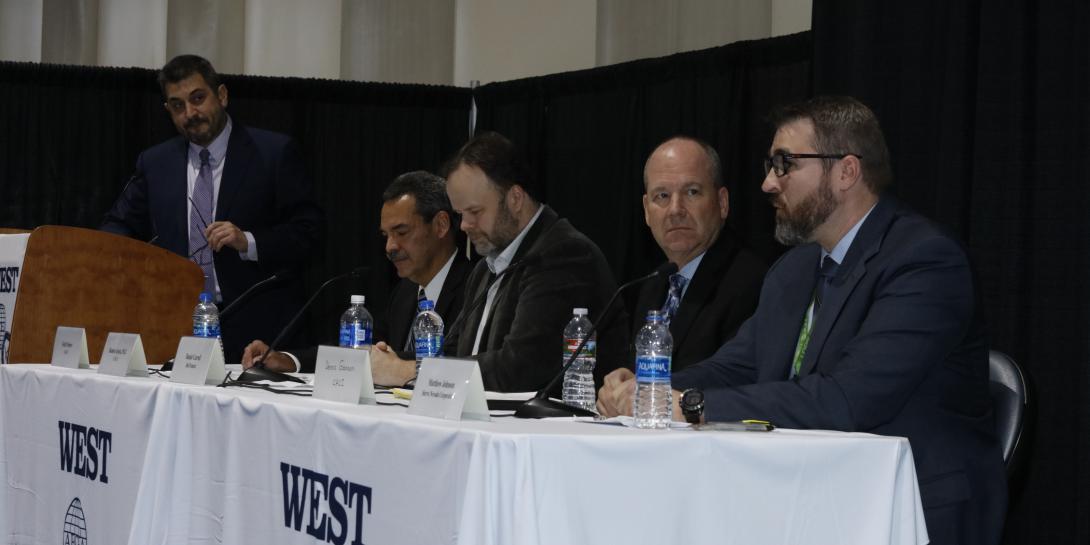Approaches, Architectures to Drive New Technologies
The key to developing amazing new technologies and capabilities for defense may lie in disciplined development, according to industry experts. The “anything goes” approach to innovation may give way to more structured architectures that ensure the customer receives what it wants and needs.
A panel of industry experts gave a glimpse of the future by describing the present at WEST 2022, the conference and exposition hosted by AFCEA International and the U.S. Naval Institute in San Diego February 16-18. They described many approaches that only recently have been embraced as the key to what might emerge from commercial laboratories and research facilities.
One approach that is almost becoming mandatory is DevSecOps, for development, security and operation. Matthew Johnson, senior principal software engineer, Sierra Nevada, said it is becoming commonplace—"now building security in instead of frosting it on.” He also cited “software-defined everything” as a core capability becoming dominant.
The government is getting much better at throwing boundaries around what defines open architecture.—Matthew Johnson, sr. principal software engineer, @SierraNevada #WEST2022
— Bob Ackerman (@rkackerman) February 17, 2022
“Open system architectures is more than a buzzword,” said Ramon Acosta, director, CACI. “It’s really embracing components from government or third-party providers.” Johnson added that, “The government is getting much better at throwing boundaries around what defines open architecture.”
Open system architectures is more than a buzzword. It’s really embracing components from government or third-party providers.—Ramon Acosta, director, CACI @CACIIntl #WEST2022
— Bob Ackerman (@rkackerman) February 17, 2022
Dennis Giannoni, CACI systems engineer, noted, “There are limitations with hardware and software for augmented reality. So, we’re learning machine learning to look at the object … for object recognition.” Daniel T. Carroll, field chief technology officer, Dell Federal, added that data governance is going to be essential for effective artificial intelligence (AI).
There are limitations with hardware and software for augmented reality. So, we’re learning machine learning to look at the object … for object recognition.—Dennis Giannoni CACI systems engineer @CACIIntl #WEST2022
— Bob Ackerman (@rkackerman) February 17, 2022
Todd Probert, president, National Security and Innovative Solutions, CACI, offered that, “AI is going to be very much like the journey [the Defense Department] is on with cyber.”
AI is going to be very much like the journey DOD is on with cyber.—Todd Probert, president, National Security and Innovative Solutions, CACI @CACIIntl #WEST2022
— Bob Ackerman (@rkackerman) February 17, 2022
Carroll also offered that research and collaboration in advanced programs has grown much better. Among esoteric technologies, quantum sensing “will give us things we couldn’t even dream of today.”
Johnson noted that systems on a chip will be important. “We need better receivers and better processing at the end. We now have more bandwidth to move,” he observed.
The supply chain will be more important than ever, but the worst potential bottleneck will not be in production. Carroll warned of issues with the rare earths and other materials needed to produce tomorrow’s devices. This will worsen over the next 15 years, he said, emphasizing, “Getting access to [vital] elements is going to be critical.”
Supply chain is going to be a critical issue and will continue to grow in the next 15 years. Getting access to [vital] elements is going to be critical.—Daniel T. Carroll, field CTO, Dell Federal @Dell #WEST2022
— Bob Ackerman (@rkackerman) February 17, 2022
Carroll cut right to the heart of the issue with one statement. “We’ll be fighting tomorrow’s wars with tomorrow’s technologies,” he predicted.





Comments